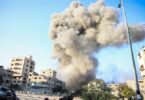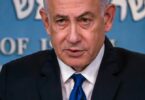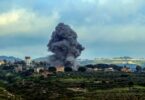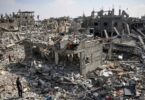Mary Dudziak
When President Joe Biden announced on August 31, 2021, that the war in Afghanistan had ended, he also emphasized that the US use of force in the region would continue.
“We just don’t need to fight a ground war to do it,” he explained. “We have w-hat’s called over-the-horiz-on capabilities, which mea-ns we can strike terrorists and targets without Amer-ican boots on the ground—or very few, if needed.”
An early milestone in the administration’s remote war strategy was the killing of Al Qaeda leader Ayman al-Zawahri nearly a year later. Remote war that relies on machines rather than human soldiers has advantages — particularly protecting the lives of American military personnel. Drone warfare has been criticized for its impact on civilians in conflict zones, however. It can also undermine transparency, public awareness in the US, and political accountability, thereby enabling endless war.
Controlling the Message
During US ground wars, American presidents understood that public awareness and engagement were crucial.
US photo censorship during World War II illustrates the way the government can curate an image of remote war in order to calibrate public engagement. When World War II began, US censors blocked graphic images of US casualties out of concern that they might fuel antiwar sentiment. As the war dragged on, President Franklin D. Roosevelt was concerned about domestic complacency. He needed more than political support for the administration’s war effort. Public commitment to war support might keep workers on the job for long hours producing war materiel. In order to enhance public support, FDR eased photo censorship, thinking that more graphic images might motivate US civilians.
A result of this change was the first photograph of the bodies of dead Amer-ican soldiers published in Life magazine in 1943. Three dead men in US military uniforms lay on the sand after a battle on Buna Beach, New Guinea. The image is gentle for a war photograph. The bodies are intact. Their faces are not visible. A transport vehicle is partly submerged in the bay, but otherwise it is not a scene of devastation. Still, the editors expected the photo of dead US soldiers to provoke outrage, so they accompanied it with an editorial defending the importance of showing Americans what their soldiers were experiencing.
The fuller war experience of course remained hidden for years in classified files, including a shocking Army Signal Corps photo of a jumbled pile of American dead bodies waiting for transport in New Guinea now accessible in the National Archives.
During World War II — through both censorship and release of selected im-ages of harm to US perso-nnel — the federal government sought to shape the public’s understanding of the war. The purpose was to maintain domestic war support, and to dampen both complacency and antimilitarism.
Release of certain media coupled with censorship continued in later US wars, but independent journalism and photography began to shape a more graphic and candid view of war, which is not what the government wanted. The result: rising awareness about civilian harm, such as the famous photograph of nine-year-old Phan Thi Kim Phuc in Vietnam, running naked after being burned by napalm, and photos of massacred civilians at My Lai. In contrast, there were no photojournalists at the No Gun Ri massacre early in the Korean War, and those civilian killings by American soldiers are not well known.
Moreover, these brutal images, combined with the footage of thousands of US soldiers coming home in coffins and with devastating injuries, invigorated support for the antiwar movement, helping to hasten the end of the war.
Further distancing Americans from war
Twenty years later, war technology changed what the American public could see. During the brief Pers-ian Gulf War of 1991 the only images were distant explosions on CNN, with General Norman Schwa-rzkopf sharing the glories of a new laser-guided missile seeking its target. Compared with Vietnam Warera carpet bombing, “precision” made war seem more humane and cleaner.
During the Global War on Terror, increasing reliance on air strikes and drone technology has made machines the new American military heroes. The persistent difficulty, however, is that accurate targeting depends on intelligence — a problem amplified more recently during the US pullout from Afghanistan, when an Afghan employee for a US humanitarian nonprofit was misidentified as a threat. He and ten family members were killed in a drone strike.
Use of drones has meant fewer US boots on the ground, however, reducing American military casualties. This is, of course, a benefit for American families. It also has a consequence for democratic limits on war powers. Most Americans do not have relatives deployed in our ongoing wars, even as drone operators, who are far from the site of conflict. There are fewer scenes of US coffins arriving at Dover airfield. American casualties sometimes lead the US public to pay attention to war. When the mounting casualties are instead foreign civilians, a distracted public pays little attention.
In contrast to the World War II years, American presidents are not seeking to deepen the citizenry’s engagement with war. They do not need to follow Roosevelt in seeking to ignite the public’s sense of sacrifice. Instead, most of the time, war goes on behind the scenes. Presidential power does not depend on domestic mobilization. Instead, it is enabled by the public’s inattention.
Public engagement can help end wars, as we know from the US war in Vietnam. Public disengagement enables war to go on in the background, far from everyday life in the United States. The idea of “over the horizon” war is a signal to Americans that war happens someplace else. It won’t hurt them. It doesn’t need to bother them.
This makes journalism — in spite of the challenges posed by drone war— more important than ever, enabling civilians to see the human face of conflict. Public awareness alone may not end ongoing war, but it is an essential precondition to reinvigorating political limits on US war powers.
Courtesy: Responsible Statecraft.






